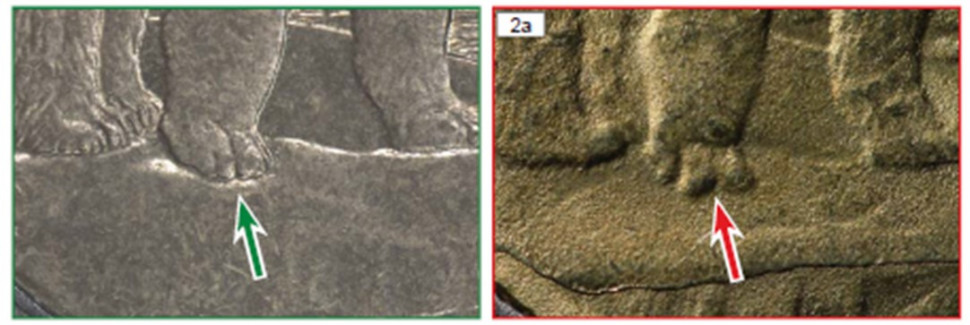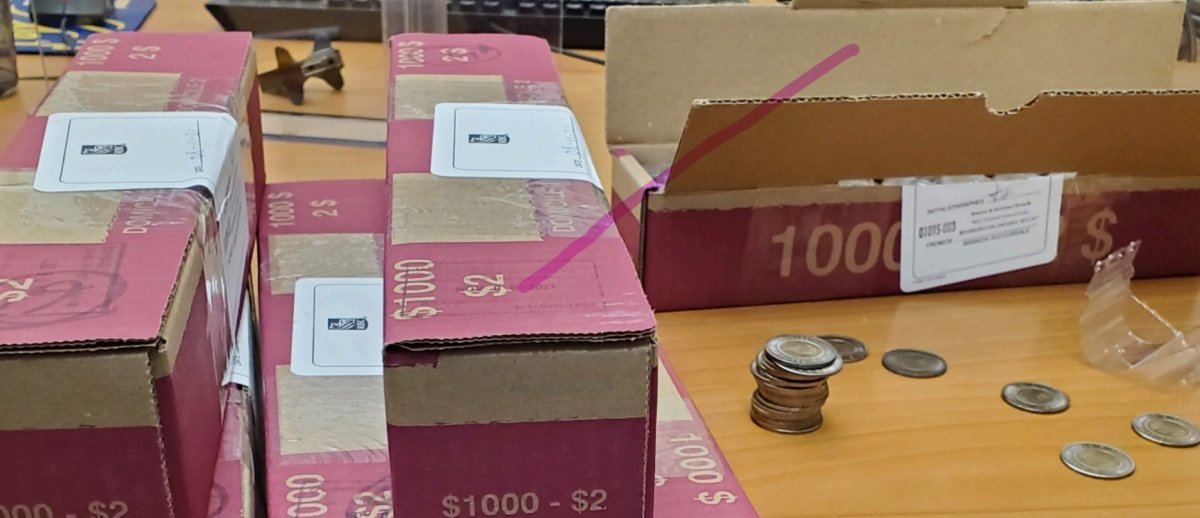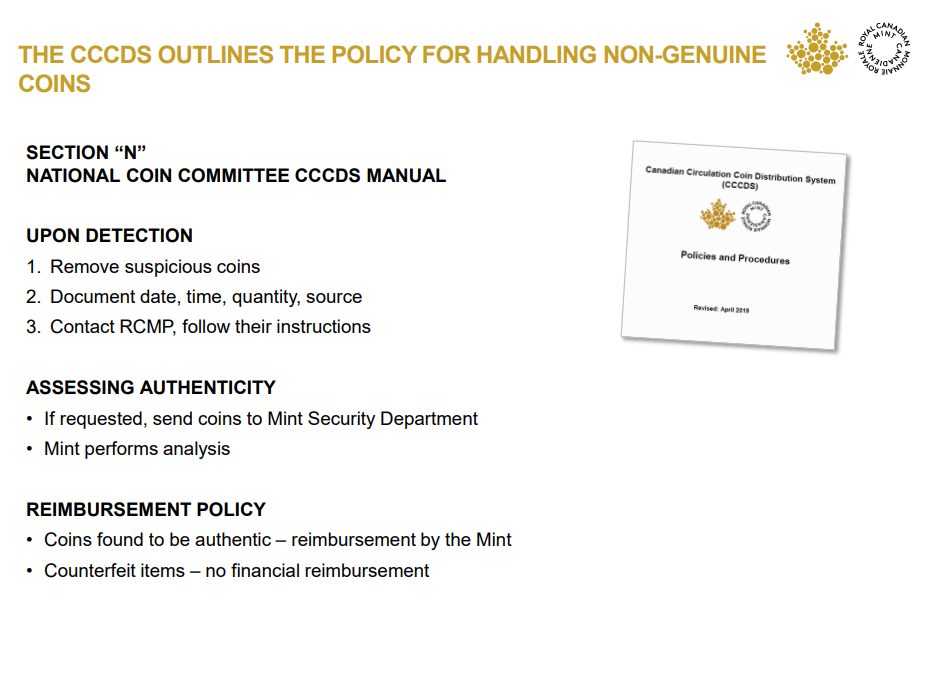A Toronto-area man has been fined $100,000 after he quietly pleaded guilty to possession and fraudulent use of thousands of counterfeit $2 coins after depositing the fakes into Canada’s banking system, Global News has learned.

During a brief court appearance in Newmarket on Dec. 9, 2022, That Daixiong He, 69, of Richmond Hill, Ont., admitted he was guilty for his use of fake toonies.
His plea came after he was caught injecting thousands of fake toonies into Canada’s banking system by making large deposits into several of his personal accounts at BMO, HSBC and RBC.
There also is a second person of interest in this case who appears to have escaped a deportation attempt.
Global News was unable to reach Mr. He for comment. He received no prison time, even though he faced a maximum sentence of 14 years in jail.
Ontario General Court Justice Amit Ghosh fined Mr. He $100,000 after he admitted to breaching two sections of the Criminal Code (452 a and 450 b) for “uttering and possessing” counterfeit $2 coins between Jan. 4, 2021, and Nov. 12, 2021 “without lawful justification or excuse.”
The Crown later agreed to stay the second charge of possessing fake toonies after Mr. He paid his fine by electronic bank draft, court records show.
His guilty plea came after a probe by the RCMP’s Trans-National Serious and Organized Crime unit in Toronto, led by Supt. Ann Koenig, with involvement by Fintrac, the federal government’s financial intelligence agency.
Mr. He’s arrest was announced with fanfare in May 2022 after a flood of fake toonies began circulating in Greater Toronto during the summer of 2020.
The fake $2 coins at the centre of the counterfeiting scheme became known as “Camel Toe Toonies.” That’s because counterfeit experts spotted the fake coins by the outsized toes on the polar bear’s right paw on the fake coins.
Richmond Hill defence counsel Thomas Richards, who represented Mr. He, said his client had possessed “a significant amount” of fake toonies, without saying how many. Mr. He “divested” himself of all his fake toonies a few months before his arrest, Richards added, without elaborating.
That’s when Global News learned previously undisclosed details of the RCMP investigation into Mr. He’s actions, including how up to 40,000 fake toonies were injected into the Canadian banking system by simply depositing them at three Toronto-area banks.
The RCMP launched the investigation into counterfeit two-dollar coins circulating in Toronto in July 2021 after the Royal Canadian Mint found a high level of fakes when they statistically sampled large boxes of coins to determine percentages of genuine coins versus fakes, according to evidence in the case.
- N.S. mother ‘in shock’ after enduring 17-hour hospital wait with sick baby
- Tories grill Liberals in question period about minister’s ties to lobbyist, PPE company
- The public inquiry into foreign interference is set to present 1st report
- N.S. parent uneasy as institutions for people with developmental disabilities set to close
After police investigators obtained several production orders to force banks to disclose account and transaction information, Daixiong He was identified as a suspect who had made multiple, large bank deposits of counterfeit two-dollar coins between Jan. 4, 2021, and Nov. 12, 2021.
Investigators also learned:
- On July 26, 2021, Mr. He deposited 499 two-dollar coins into an RBC account, located at 6021 Steeles Ave. E. in Scarborough. The RCMP’s National-Anti Counterfeiting Bureau (NACB) confirmed the coins were counterfeit.
- On Oct. 2, 2021, Mr. He deposited 500 two-dollar coins into an HSBC account, located at 6025 Steeles Ave. E., Scarborough. The NACB confirmed those coins were fakes.
- On Nov. 8, 2021, the RCMP observed Mr. He deposit a large amount of cash and 3,001 two-dollar coins, at the RBC located at 6021 Steeles Ave. E., Scarborough. Again, the NACB confirmed the coins were counterfeit.
- On Nov. 12, 2021, Mr. He deposited 500 two-dollar coins into an account at the BMO located at 1 Spadina Rd, in Richmond Hill, Ontario. BMO officials examined those coins and deemed them counterfeits. The RCMP then inspected the coins, also concluded they were counterfeit and seized them.
In the period before the police and Mint began seizing confirmed counterfeit coins, RCMP investigators learned, Mr. He made similarly large $2 coin deposits totaling approximately $80,000, or about 40,000 toonies that were suspected fakes, making it the biggest fake toonie case in Canadian history.
A recent Quebec arrest involves a man accused of illegally trying to import more than 26,000 fake toonies from China. That case remains before a Quebec court.
Mr. He did not admit to making the Camel Toe fake toonies.
Rather, he admitted that because of the circumstances of how he received the coins — which were not revealed to the court — he ought to have exercised more caution before depositing them and was therefore willfully blind when he used the counterfeit money.
Asked if his client was a member of an organized crime group, lawyer Thomas Richards replied: “I can tell you there was no information in the disclosure (of the police evidence by the Crown attorney) that would tie him to organized crime. It was just simply him.”
Thomas declined to say where Mr. He obtained his fake toonies, but then added: “There was a person of interest that the police were interested in pinning this on. He was illegal in Canada but couldn’t be removed or deported because his passport expired. So, he was continuing to operate in perhaps a criminal manner inside Canada, known to police, but CBSA (Canada Border Services Agency) couldn’t remove him because he didn’t have a valid travel document.”
Thomas declined to name this person of interest or nationality, but insisted: “That’s the real story.”
Richards said that this person has not been charged, as far as he knows.
“He’s the real story. He is a known criminal,” Richards said.
The person without legal status in Canada was detained by the RCMP and Canada Border Services Agency and an attempt to deport him was made. But because the person didn’t have a passport or other travel document, and because their country of origin was either unable or unwilling to provide a new travel document to him in a timely way, the CBSA was forced to release him from its custody, and the person remains at large inside Canada.
CBSA can detain people without legal status in Canada for periods ranging from 48 hours to 30 days to prepare deportation proceedings against them, but must get permission from a federal immigration tribunal to extend that detention.
“He’s out there, the police know he’s a criminal, but they can’t do anything,” Richards added.
Global News asked the Mounties about the lawyer’s comments and whether another suspect was linked to the Toronto fake toonie case who remains at large. An RCMP spokesman did not deny it and said: “Only in the event that an investigation results in the laying of criminal charges, would the RCMP confirm the identity of individual(s) involved. Therefore, I cannot provide further information.”
Richards declined to share further details about Mr. He including his occupation, or the other person of interest, saying his client had “a right to remain mostly anonymous.”
The Royal Canadian Mint began sampling big bank-supplied boxes filled with 1,000 $2 coins in the Toronto area in the summer of 2021 to determine the extent of the counterfeiting operation. That was long after Canadian coin collectors complained of a tsunami of counterfeit toonies that had landed in the GTA in July 2020. The Mint has until this day refused to publicly disclose the results of its own coin sampling efforts.
Internal Mint documents obtained under the Access to Information Act show it did share and forward its coin sampling findings — the percentage of fakes it was finding in $1,000 boxes of coins — with the RCMP to advance the criminal investigation that led to charges against Daixiong He.
Coin collectors in the Toronto region were already doing their own amateur sampling of the same boxes of toonie rolls of coins, which can be ordered from banks. Numismatic enthusiasts were coming up with five fakes in every box of 500 coins, a one per cent counterfeit rate.
The flood of fake toonies in the GTA — which eventually spread across Canada and continue to circulate to this day — caused the Mint to draft a special plan to manage “a contamination in the circulation coinage system,” according to a Mint document that outlines its provisions.
The Mint and an entity called the Canadian Circulation Coin Distribution System even have a policy guide on how to manage the “contamination” of the Canadian circulating coin environment when counterfeit coins are detected, the Access to Information documents reveal.
An Internal Mint document shows how it manages a counterfeit coin “contamination” in Canada. It states the “magnitude (size) of the contamination informs the course of action.”





Comments